
|
Sale 51
Pre-Long Beach Coin and Currency Auction
| Lot |
Photo |
Description |
Realized |
Lot 1567 |
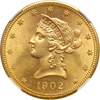 |
1902-S $10 Liberty. NGC graded MS-63. Lovely delicate golden toning. Resplendent surfaces that are thoroughly frosted with choice keen-edged, gold luster spiraling outward from the centers. 1902-S is famous for their bright luster (PCGS # 8751) .
Estimated Value $700 - 750.
View details and enlarged photos
Check results on similar lots
| Realized
$1,035 |
Lot 1568 |
 |
1905 $10 Liberty. PCGS graded MS-62 PQ. Lovely rich golden toning. Brilliant and refreshingly clean for this grade, with soft luster in the fields and sundrenched golden devices. The fields are free of most marks and so offer much eye-appeal (PCGS # 8757) .
Estimated Value $450 - 475.
View details and enlarged photos
Check results on similar lots
| Realized
$719 |
Lot 1569 |
 |
1905-S $10 Liberty. NGC graded AU-58 PQ. Nice light golden toning. Should be sent back for regrade (PCGS # 8758) .
Estimated Value $600 - 650.
View details and enlarged photos
Check results on similar lots
| Realized
$633 |
Lot 1570 |
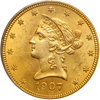 |
1907 $10 Liberty. PCGS graded MS-63. Lovely golden toning. A small mark in the right obverse field. Very frosty (PCGS # 8763) .
Estimated Value $700 - 750.
View details and enlarged photos
Check results on similar lots
| Realized
$1,035 |
Lot 1571 |
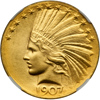 |
1907 $10 Indian. Wire rim, periods. NGC graded MS-66. An exquisite gem with superb satiny mint surfaces that are virtually immaculate. Pale yellow in color with a touch of light golden overtones at the borders on both sides. A rare and desirable transitional Type, one of a mere 500 coins made without intentions of circulation, technically making the Wire Edge ten a pattern (Judd-1774). This issue was the closest the mint came to making the ten-dollar design as conceived by Augustus Saint-Gaudens and Theodore Roosevelt. The presently offered coin has subtly variegated colors, marvelous luster, and only the smallest marks, none of which we find need to be singled out, nothing out of the ordinary. The die polishing marks (common to all specimens) are more prominent in the reverse fields. Overall the coin has a lovely vibrant satiny sheen. Pop 17; 10 finer (PCGS # 8850) .
The story on this issue is delightful and is always worth repeating. President Teddy Roosevelt took it upon himself to replace the designs on our national coinage. In a letter to the famed sculptor Augustus Saint-Gaudens, Roosevelt called the coin designs then in circulation "atrociously hideous", and further asked for Saint-Gaudens help in redesigning the coinage. Saint-Gaudens had sworn he would never work for the mint under any circumstances after submitting a magnificent design for the official medal of the 1892 Columbian Exposition. Saint-Gaudens submission featured a magnificent portrait of Columbus, with the reverse of a Grecian youth, unashamedly naked, holding torch and wreaths to crown the victors. The controlling Board of Gentlemen Managers of the Exposition accepted Saint-Gaudens models and displayed them. Soon the naked youth came to the attention of Anthony Comstock, founder of the Society for the Suppression of Vice, who at once denounced the Saint-Gaudens reverse as "obscene", and began a torrent of verbal abuse at the sculptor and the Exposition. Comstock also wielded his immense power in Congress. The Board, afraid to stand up to the fanatic, or to defend Saint-Gaudens from fundamentalist prudery, withdrew the reverse and asked Charles E. Barber to design a replacement, predictably notable in its banality. Saint-Gaudens, infuriated, swore he would go to his grave before having anything to do with the Mint Bureau again.
Fourteen years after that painful incident, President Theodore Roosevelt used his friendship with Saint-Gaudens to persuade him to design his official inaugural medal. Roosevelt confided to Saint-Gaudens his "pet crime" of wanting to redesign Barber's coinage. This seemed plausible with Roosevelt in the White House. Roosevelt specifically wanted to see the beauty and dignity displayed on Greek coins on America's coinage. Saint-Gaudens took on the challenge, and began to produce models, just as his health declined. Saint-Gaudens's pupil, Henry Hering stepped into Saint-Gaudens's shoes and completed the finishing touches on the designs and Roosevelt used all his influence to have dies made under Hering's supervision. Barber hated the personal slight, and fought the Roosevelt/Saint-Gaudens project every step of the way.
At last, dies were completed for these magnificent eagles. Having no edge, the wire rim became a problem when the coins were stacked, so they would tip over, not to mention being a handy dirt collecting device. Barber demanded they be redesigned, and sabotaged the project at every turn. Roosevelt persisted, and Hering continued to press for the original designs. Nevertheless, Barber's sabotage paid off, and the original concepts were changed in late 1907, reducing the relief adding rims to the eagles and double eagles designed by Saint-Gaudens. Meanwhile Saint-Gaudens died before any were coined, never seeing his magnificent coins in circulation. This particular coin is closest to Saint-Gauden's original design, on later issues the periods were dropped, then the design was changed a bit by Barber for the more common no periods, "Type III".
Saint-Gaudens had originally hoped to have a full standing figure of Liberty, but Roosevelt wanted only Liberty's head, so as not to detract from the stunning full person of Liberty on the double eagle. Saint-Gaudens chose the figure of Nike from his General Sherman monument (1905) for the obverse head, Roosevelt then requested the Indian war bonnet be added, possibly to conceal the Sherman monument connection, and thus minimize protests from the South. No Native American woman would have worn such a war bonnet, but the powers that be insisted, so there it is. (See Breen's Encyclopedia for more).
Estimated Value $65,000 - 75,000.
View details and enlarged photos
Check results on similar lots
| Realized
$74,750 |
Lot 1572 |
 |
1907 $10 Indian. Rounded rim, periods. PCGS graded MS-65 PQ. A coin of virtual perfection thus our Premium Quality designation. Here is a superb satiny mint gem with immaculate surfaces throughout and all is enhanced by a touch of golden sunset toning. Although the PCGS population lists 17 finer, we cannot imagine that is the actual case and thus this splendid gem is worthy of a premium bid. A mere 50 were struck.
Flawless revolving gold surfaces combine with an essentially perfect strike to make this a breath-taking Gem specimen of the first date and type of the Saint-Gaudens design. Edges are raised and boldly defined with a "rolled" look not seen on other 1907-dated issues. The rim is there to protect legends and devices from wear in circulation and during stacking in bank coin trays. The announcement that this coin was never handled or in circulation should come as no surprise, for the glow from the surface is rich with vibrancy and life, metaphorically speaking. Around the inner margin are 13 stars and, on the reverse, the usual legend (but without IN GOD WE TRUST); and the somewhat indistinct detail convinced Mint Superintendent John S. Landis that it made the coins look ''sweated,'' (his word) or super-heated to ''sweat'' measurable amounts of gold from genuine coins. The coin itself is identifiable from the few others in this grade by a pair of tiny marks on the right leg of the eagle (one is horizontal and below it, a slightly larger diagonal contact mark). You can generally tell a coin's character from its features. And collectors who have an instinct for "character" will spot it in this coin in a heartbeat. Put simply, this spectacular rarity is destined to be a centerpiece in some high-quality gold collection featuring only the finest and rarest treasures in American numismatics. Pop 16; 17 finer, 14 in 66, 3 in 67 (PCGS # 8851) .
Augustus Saint-Gaudens' so-called "Indian" Head Eagles are more properly a concoction of his creative genius having to mold itself to the political realities of coin design. Read some of Walter Breen's acidic commentary on how this special coin came about: "For the new eagle design, Augustus St. Gaudens [sic] (in consultation with Pres. Theodore Roosevelt) decided to use not a standing figure but a head, feeling that the heroic effect of any standing figure, as chosen for the double eagle, would be lost in smaller diameter. The President disgusted beyond measure at what he called our 'atrociously hideous' coinage, had asked St. Gaudens to design replacements.
The profile St. Gaudens chose originated in a figure of Nike ('Victory'), part of his Gen. Sherman Monument (1905), ultimately inspired by a Hellenistic Wingless Victory on the temple of Zeus Soter. at Pergamon. At Pres. Roosevelt's insistence, and for no other reason, St. Gaudens gave this head a nationalistic character by the absurd addition of a feathered war bonnet, such as neither Ms. Liberty nor any Native American woman would have ever worn."
Estimated Value $200,000 - 225,000.
View details and enlarged photos
Check results on similar lots
| Realized
$230,000 |
Lot 1573 |
 |
1907 $10 Indian. No periods. NGC graded MS-66 CAC Approved. A stunning gem specimen with boasting hints of iridescence. This is an utterly captivating example with fresh yellow gold luster and exceptional aesthetic appeal. Both obverse and reverse have extraordinary design features with a full strike. The iridescence noted can be found in the field around devices on both sides. The No Motto No Periods issue of 1907 is a very important one as it introduced the production coinage in the proper relief for circulation strikes. Common enough in lower Uncirculated grades, in superb gem quality such as offered here, the issue is an important offering. From this information, we can certainly see that the present example is an desirable issue. Pop 165; 32 finer (PCGS # 8852) .
Estimated Value $20,000 - 22,000.
View details and enlarged photos
Check results on similar lots
| Unsold |
Lot 1574 |
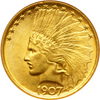 |
1907 $10 Indian. No periods. NGC graded MS-65. Lovely rich golden toning on both sides. Popular first year of issue. This is a dazzling gold specimen of the No Motto, No Periods Indian $10 of the first year of issue. The coin displays burning-gold mint bloom, and is powerfully struck and preserved without a flaw. Normal detail on all devices is typical for this issue; however, with present specimen we see a wonderful exception in the broad regions of crisp strike found on the hair waves and eagle's wing and body. A remarkable coin. Pop 314. (PCGS # 8852) .
The first of these coins struck had no motto IN GOD WE TRUST as had the later issues, starting in 1908. President Theodore Roosevelt personally objected to the use of the Deity's name on coins. The motto was restored to the coins by an act of Congress in 1908.
Estimated Value $8,000 - 8,500.
View details and enlarged photos
Check results on similar lots
| Realized
$8,338 |
Lot 1575 |
 |
1910 $10 Indian. PCGS graded MS-64. Very well struck with just a hint of light golden toning. Fully original and uncleaned, as benefits a coin in which the surfaces are awash in rich reddish-gold color. Don't expect the usual halfhearted impression left by the striking of the (sometimes worn) dies that made this piece, for we are glad to report the opposite is true. This has a very bold impression with sharp feathers and legends. Pop 182; 66 finer (PCGS # 8865) .
Estimated Value $2,000 - 2,200.
View details and enlarged photos
Check results on similar lots
| Unsold |
Lot 1576 |
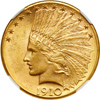 |
1910-D $10 Indian. NGC graded MS-63. Well struck and choice for the grade with a nice smooth cheek on Liberty. Bright with tawny-gold color, both sides exhibit minimal blemishes while the luster has a typical velvet-like smoothness seen on pre-1920 dated Indian tens. In 1908 to 1910, the "D" mintmark is large and broad; later, the mint would switch to a smaller mintmark punch for 1911-D and 1914-D (PCGS # 8866) .
Estimated Value $950 - 1,000.
View details and enlarged photos
Check results on similar lots
| Realized
$1,323 |
Lot 1577 |
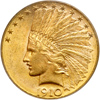 |
1910-D $10 Indian. PCGS graded MS-63. Hint of gold toning. A popular, affordable Type with Saint-Gaudens stylized "Indian head" motif (PCGS # 8866) .
Estimated Value $950 - 1,000.
View details and enlarged photos
Check results on similar lots
| Realized
$1,265 |
Lot 1578 |
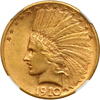 |
1910-S $10 Indian. NGC graded AU-53. Light pinkish-golden toning. Much original luster (PCGS # 8867) .
Estimated Value $500 - 525.
View details and enlarged photos
Check results on similar lots
| Realized
$805 |
Lot 1579 |
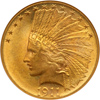 |
1911 $10 Indian. NGC graded MS-64. Light delicate golden toning which is barely able to tame the vibrant luster that shines from within. An extremely attractive specimen of this early Indian ten whose smooth finish and sharp relief gives it the nod in our estimation for anyone desirous of owning this Type (PCGS # 8868) .
Estimated Value $2,400 - 2,500.
View details and enlarged photos
Check results on similar lots
| Unsold |
Lot 1580 |
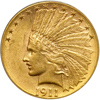 |
1911-D $10 Indian. PCGS graded AU-58. There is luster everywhere on this choice coin, with only the faintest rub on the high points to show it had a minor brush with circulation before it went into hiding. The 1911-D is a scarce one, as all collectors of this series know or soon find out: only 30,100 minted. Pop 82 (PCGS # 8869) .
Estimated Value $2,500 - 2,600.
View details and enlarged photos
Check results on similar lots
| Realized
$3,220 |
Lot 1581 |
 |
1912 $10 Indian. NGC graded Proof 66. A stunning Gem matte Proof with uniform golden-tan surfaces and completely free from shiny spots. We note a microscopic hairline below the motto, probably from a hair that adhered to the die when struck. This is mentioned mainly for identification purposes. Struck in the a similar sand-blast finish to the 1911 Proof Indian tens, though it is slightly lighter than the darker matte color seen in the previous years, the Philadelphia Mint was trying to please a disparate clientele with these, varying the sand-blasting method for Proofs year by year. The darker matte finish gave way to this lighter finish in 1912. Only 83 Proofs minted. Pop 8; 6 finer with 5 in 67, 1 in 68 (PCGS # 8894) .
Estimated Value $50,000 - 55,000.
View details and enlarged photos
Check results on similar lots
| Realized
$44,850 |
Lot 1582 |
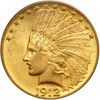 |
1912 $10 Indian. PCGS graded MS-63. Lightly toned. Liberty is decked in a fancy feathered bonnet in this beautiful rendition. Considered to be among the most attractive designs ever (PCGS # 8871) .
Estimated Value $900 - 925.
View details and enlarged photos
Check results on similar lots
| Realized
$1,380 |
Lot 1583 |
 |
1912-S $10 Indian. NGC graded EF-45. Lustrous with a few light surface marks on both sides (PCGS # 8872) .
Estimated Value $475-UP.
View details and enlarged photos
Check results on similar lots
| Realized
$604 |
Lot 1584 |
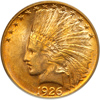 |
1926 $10 Indian. PCGS graded MS-63. Lovely golden-orange mint bloom color with outstanding detail. A few light contact marks for the grade including a small one on the tip of the chin. The booming luster seen on 1926-dated pieces makes this year a favorite among Type Set collectors (PCGS # 8882) .
Estimated Value $900 - 925.
View details and enlarged photos
Check results on similar lots
| Realized
$1,265 |
Lot 1585 |
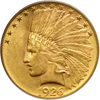 |
1926 $10 Indian. PCGS graded MS-63. Lightly toned. Choice, frosty surfaces throughout. A few light marks at the chin and neck; a few others in the reverse field (PCGS # 8882) .
Estimated Value $900 - 925.
View details and enlarged photos
Check results on similar lots
| Realized
$1,093 |
Lot 1586 |
 |
1926 $10 Indian. PCGS graded MS-63. Lightly toned. Some scattered bagmarks consistent with this grade. Frosty (PCGS # 8882) .
Estimated Value $900 - 925.
View details and enlarged photos
Check results on similar lots
| Realized
$1,150 |
Lot 1587 |
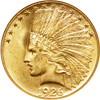 |
1926 $10 Indian. NGC graded MS-63. Mostly untoned and choice for the grade. Large mintage and ample supply of choice examples makes the 1926 issue ideal for gold Type Set collections (PCGS # 8882) .
Estimated Value $900 - 925.
View details and enlarged photos
Check results on similar lots
| Realized
$1,150 |
Lot 1588 |
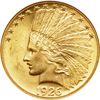 |
1926 $10 Indian. NGC graded MS-62. Mostly untoned with brilliant frosty luster from top to bottom (PCGS # 8882) .
Estimated Value $700 - 750.
View details and enlarged photos
Check results on similar lots
| Realized
$891 |
Lot 1589 |
 |
1926 $10 Indian. AU-50. Lightly cleaned. Bright luster everwhere with only a touch of wear on the high points.
Estimated Value $475 - 500.
View details and enlarged photos
| Realized
$690 |
Lot 1590 |
 |
1932 $10 Indian. PCGS graded MS-64. A touch of warm sunset toning adds to its appeal. 1932 along with 1926 and 1910-D are the three peak years in mintage within the confines of this series that ran from 1907 to 1933. Examples in choice MS64 condition, while regularly available, are scarcer than the more bagmarked low-grade examples the populate the bourse floors around the country (PCGS # 8884) .
Estimated Value $1,700 - 1,800.
View details and enlarged photos
Check results on similar lots
| Realized
$2,013 |
Lot 1591 |
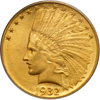 |
1932 $10 Indian. PCGS graded MS-63. Lightly toned. A frosty golden example (PCGS # 8884) .
Estimated Value $900 - 925.
View details and enlarged photos
Check results on similar lots
| Realized
$1,150 |
Lot 1592 |
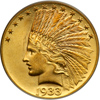 |
1933 $10 Indian. PCGS graded MS-65 PQ. Well struck with exquisite natural toning. This incredible gem shimmers with original mint bloom colors. A remarkablly clean example, free from the cuts on the cheek that seem to plague others. The Key Date to the entire Indian Eagle series. An example in our Ohringer Part II Sale, Sept. 2008, lot 1285, NGC MS-65 realized $450,000. This gem being offered is a finer quality example.
Unlike the pre-1920 Indian tens which have a satiny finish, the 1933-dated coins (of which almost all known examples are Mint State) display decidedly frosted mint luster. This piece has, in addition to a golden-orange hue, shades of natural reddish-gold color from the 10% copper alloy used to improve wearability of America's .900 Fine gold coins. The surfaces are exceedingly clean even for a Gem, with virtually no abrasions on the face and neck, and only two slight contacts from stacking at the eagle's wing below the P in PLURIBUS. The design details are razor-sharp throughout, as expected, the 1933 issue being one of the best made $10 gold pieces in the series. A landmark and most spectacular coin for the rarities connoisseur.
In 1933, Franklin Roosevelt assumed leadership of a nation in despair. Banks were closing across the country. Among the country's myriad problems, commodity price deflation had driven many Americans to the point of desperation. One strategy Roosevelt adopted in an attempt to address the commodity price problem was a year-long manipulation of gold. He would attempt to induce inflation, thus raising prices, particularly commodity prices. Roosevelt's strategy moved through three phases.
Immediately upon assuming office, Roosevelt instructed the U.S. Treasury to cease honoring requests from Americans to exchange their paper dollars for gold. This was the first step in removing America from the gold standard. Dollars would, he hoped, remain in circulation and be available for commodity purchases. With prices continuing to drop, however, the President convinced Congress to make unenforceable all contract clauses calling for payment in gold, a common payment requirement in both government and private contracts of the time. This would reduce pressures upon the Treasury to release more gold into the economy. Prices continued to fall. In a final attempt to mitigate the country's economic depression through gold manipulation, Roosevelt and his advisors tried to circumvent market forces by personally manipulating the price that the U.S. Government would pay to buy gold still in circulation. By driving up gold's value, the Administration hoped to pull the metal from the marketplace, to be replaced by paper currency. By January 1934, Roosevelt had revalued the gold price to $35 an ounce from the $20.67 it had been before. (From "Gold Follies of 1933.")
Now, on to the coin: Following its huge mintage of 4,463,000 pieces in 1932, attesting to the panic hoarding then going on, the Philadelphia Mint opened 1933 with a decent supply of 312,500 eagles in January and February. A few of these coins, perhaps 30-40 pieces, were legally released through ordinary channels at this time. The aforesaid presidential order concerning gold withdrawals not only arrested gold coin production, but drove the Philadelphia Mint to melt all residual 1933 eagles. Fewer than 30 came to light in an east coast hoard circa 1952, according to sources. Although a few more individual specimens have since turned up in French and Swiss banks, the 1933 still holds top honors as the rarest Indian eagle in all grades. Pop 7; none finer at PCGS (PCGS # 8885) .
Estimated Value $450,000 - 500,000.
View details and enlarged photos
Check results on similar lots
| Realized
$517,500 |
|
|